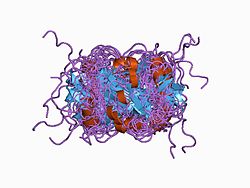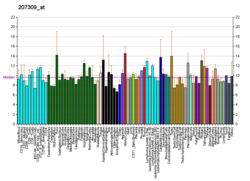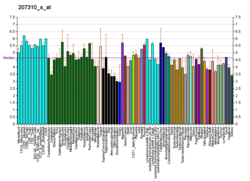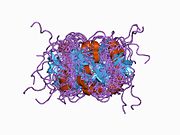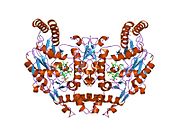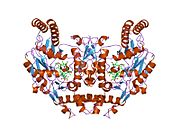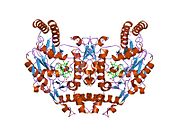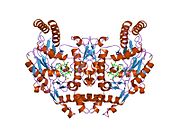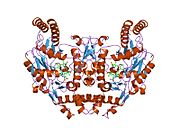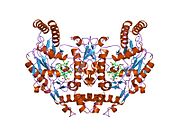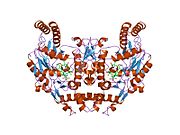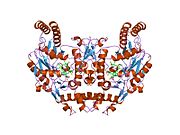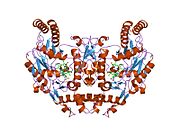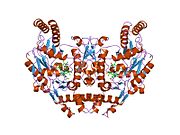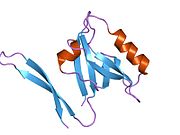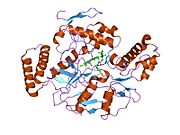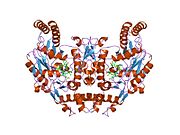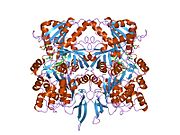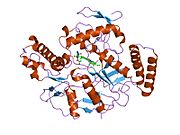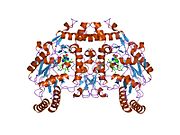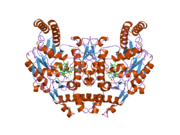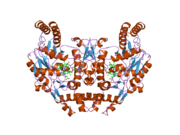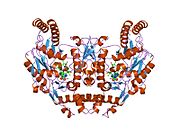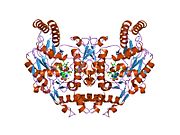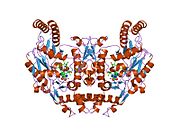NOS1
NOS1NOS1이라고도 알려진 질소산화물 싱타아제 1(신질)은 인간에서 NOS1 유전자에 의해 인코딩되는 효소다.[5][6]
함수
질소산화물 동기화(EC 1.14.13.39) (NOSs)는 L-arginine으로부터 질소산화물(NO)의 생성을 촉진하는 동기화 제품군이다. NO는 효소 소스와 조직 국산화 등에 따라 체내 다양한 기능을 가진 화학 메신저다. NOS1이 주로 존재하는 뇌와 말초신경계에서는 NO가 신경전달물질의 많은 특성을 나타내며 장기적 전위작용에 관여할 수 있다. 뇌졸중 및 신경퇴행성 질환과 관련된 신경독성, 근막 및 괄약근 이완을 포함한 평활근의 신경조절, 음경 발기 등에 관여한다. NO는 또한 관련된 효소 NOS3에서 생성된 혈압을 조절하는 내피 유도 이완 인자 활동에도 책임이 있다. 대식세포에서 NO는 관련 효소 NOS2에서 생성된 종양 및 살균 작용을 매개하지 않는다. NO 신시네시스(NOS)의 다양한 약리학적 억제제가 이러한 효과를 차단하지만, 그 기능의 추가 구분이 이러한 특정 유전자가 비활성화된 동물 모델에 의해 해명되어 왔다. 뉴런 NOS(Neuronal NOS), 내피 NOS(NOS3) 및 유도성 NOS 대식세포 NOS는 구별되는 등소형이다.[7] 뉴런과 대식세포 형태 모두 여러 전자 기증자를 필요로 하는 산화 효소들 사이에서 특이하다: 플라빈 아데닌 디뉴클레오티드(FAD),[8] 플라빈 모노뉴클레오티드(FMN), NADPH, 테트라하이드로바이오프로테린.
임상적 유의성
그것은 천식,[9][10] 정신분열증,[11][12] 안절부절못하는 다리 증후군,[13] 그리고 정신운동성 신경독성에 관련되어 있다. 또한 조울증[14] 및 대기오염 노출과 관련하여 조사되었다.[15]
상호작용
NOS1은 DLG4[16][17] 및 NOS1AP와 상호작용하는 것으로 나타났다.[16]
참고 항목
참조
- ^ a b c GRCh38: 앙상블 릴리스 89: ENSG000089250 - 앙상블, 2017년 5월
- ^ a b c GRCm38: 앙상블 릴리스 89: ENSMUSG000029361 - 앙상블, 2017년 5월
- ^ "Human PubMed Reference:". National Center for Biotechnology Information, U.S. National Library of Medicine.
- ^ "Mouse PubMed Reference:". National Center for Biotechnology Information, U.S. National Library of Medicine.
- ^ Kishimoto J, Spurr N, Liao M, Lizhi L, Emson P, Xu W (November 1992). "Localization of brain nitric oxide synthase (NOS) to human chromosome 12". Genomics. 14 (3): 802–4. doi:10.1016/S0888-7543(05)80192-2. PMID 1385308.
- ^ Geller DA, Lowenstein CJ, Shapiro RA, Nussler AK, Di Silvio M, Wang SC, Nakayama DK, Simmons RL, Snyder SH, Billiar TR (April 1993). "Molecular cloning and expression of inducible nitric oxide synthase from human hepatocytes". Proc. Natl. Acad. Sci. U.S.A. 90 (8): 3491–5. Bibcode:1993PNAS...90.3491G. doi:10.1073/pnas.90.8.3491. PMC 46326. PMID 7682706.
- ^ Lowenstein CJ, Glatt CS, Bredt DS, Snyder SH (August 1992). "Cloned and expressed macrophage nitric oxide synthase contrasts with the brain enzyme". Proc. Natl. Acad. Sci. U.S.A. 89 (15): 6711–5. Bibcode:1992PNAS...89.6711L. doi:10.1073/pnas.89.15.6711. PMC 49573. PMID 1379716.
- ^ "Entrez Gene: NOS1 Nitric oxide synthase 1 (neuronal)".
- ^ Grasemann H, Yandava CN, Drazen JM (December 1999). "Neuronal NO synthase (NOS1) is a major candidate gene for asthma". Clin. Exp. Allergy. 29. 29 Suppl 4: 39–41. PMID 10641565. Archived from the original on 2013-01-05.
- ^ Leung TF, Liu EK, Tang NL, Ko FW, Li CY, Lam CW, Wong GW (October 2005). "Nitric oxide synthase polymorphisms and asthma phenotypes in Chinese children". Clin. Exp. Allergy. 35 (10): 1288–94. doi:10.1111/j.1365-2222.2005.02342.x. PMID 16238787. S2CID 24110873.
- ^ Shinkai T, Ohmori O, Hori H, Nakamura J (2002). "Allelic association of the neuronal nitric oxide synthase (NOS1) gene with schizophrenia". Mol. Psychiatry. 7 (6): 560–3. doi:10.1038/sj.mp.4001041. PMID 12140778.
- ^ Reif A, Herterich S, Strobel A, Ehlis AC, Saur D, Jacob CP, Wienker T, Töpner T, Fritzen S, Walter U, Schmitt A, Fallgatter AJ, Lesch KP (March 2006). "A neuronal nitric oxide synthase (NOS-I) haplotype associated with schizophrenia modifies prefrontal cortex function". Mol. Psychiatry. 11 (3): 286–300. doi:10.1038/sj.mp.4001779. PMID 16389274.
- ^ Winkelmann J, Lichtner P, Schormair B, Uhr M, Hauk S, Stiasny-Kolster K, Trenkwalder C, Paulus W, Peglau I, Eisensehr I, Illig T, Wichmann HE, Pfister H, Golic J, Bettecken T, Pütz B, Holsboer F, Meitinger T, Müller-Myhsok B (February 2008). "Variants in the neuronal nitric oxide synthase (nNOS, NOS1) gene are associated with restless legs syndrome". Mov. Disord. 23 (3): 350–8. doi:10.1002/mds.21647. PMID 18058820. S2CID 42425890.
- ^ Buttenschön HN, Mors O, Ewald H, McQuillin A, Kalsi G, Lawrence J, Gurling H, Kruse TA (January 2004). "No association between a neuronal nitric oxide synthase (NOS1) gene polymorphism on chromosome 12q24 and bipolar disorder". Am. J. Med. Genet. B Neuropsychiatr. Genet. 124B (1): 73–5. doi:10.1002/ajmg.b.20040. PMID 14681919. S2CID 45596789.
- ^ Steenackers W, De Herdt E, De Boever P, Bos I, Int Panis L (2013). "Neuroinflammation induced by air pollution: gene expression analysis in laboratory animals". Master Thesis, GROUP T – Leuven Engineering College.
- ^ a b Jaffrey SR, Snowman AM, Eliasson MJ, Cohen NA, Snyder SH (January 1998). "CAPON: a protein associated with neuronal nitric oxide synthase that regulates its interactions with PSD95". Neuron. 20 (1): 115–24. doi:10.1016/S0896-6273(00)80439-0. PMID 9459447. S2CID 14613261.
- ^ Brenman JE, Chao DS, Gee SH, McGee AW, Craven SE, Santillano DR, Wu Z, Huang F, Xia H, Peters MF, Froehner SC, Bredt DS (March 1996). "Interaction of nitric oxide synthase with the postsynaptic density protein PSD-95 and alpha1-syntrophin mediated by PDZ domains". Cell. 84 (5): 757–67. doi:10.1016/S0092-8674(00)81053-3. PMID 8625413. S2CID 15834673.
추가 읽기
- Miyagoe-Suzuki Y, Takeda SI (2001). "Association of neuronal nitric oxide synthase (nNOS) with alpha1-syntrophin at the sarcolemma". Microsc. Res. Tech. 55 (3): 164–70. doi:10.1002/jemt.1167. PMID 11747091. S2CID 28225242.
- Waddington SN (2002). "Arginase in glomerulonephritis". Kidney Int. 61 (3): 876–81. doi:10.1046/j.1523-1755.2002.00236.x. PMID 11849441.
- Rotilio G, Aquilano K, Ciriolo MR (2004). "Interplay of Cu,Zn superoxide dismutase and nitric oxide synthase in neurodegenerative processes". IUBMB Life. 55 (10–11): 629–34. doi:10.1080/15216540310001628717. PMID 14711010. S2CID 19518719.
이 기사는 공공영역에 있는 미국 국립 의학 도서관의 텍스트를 통합하고 있다.
